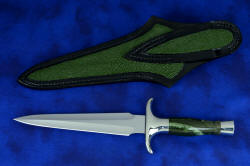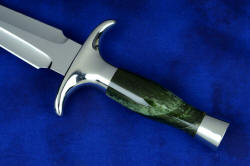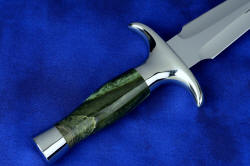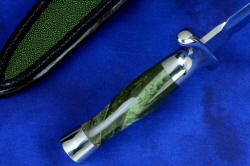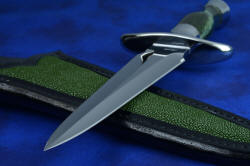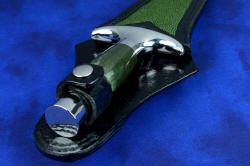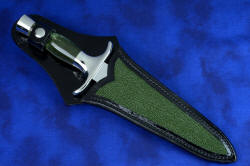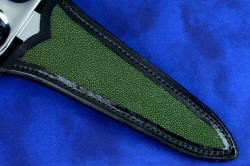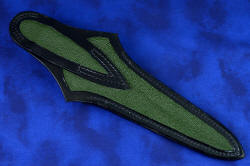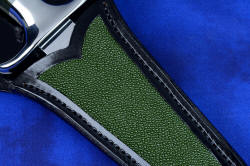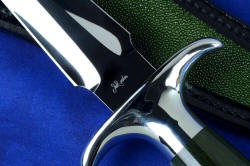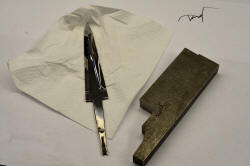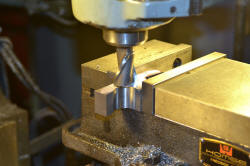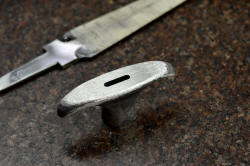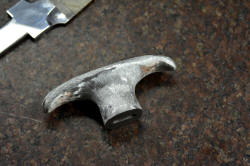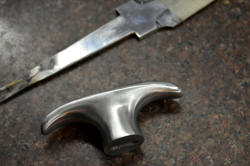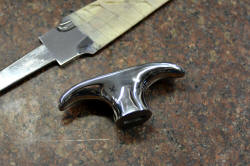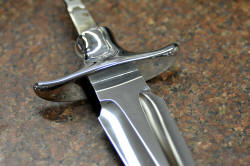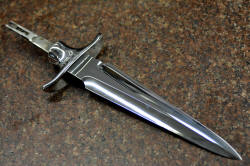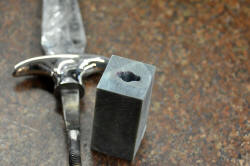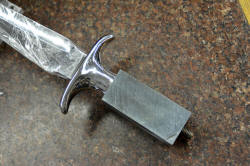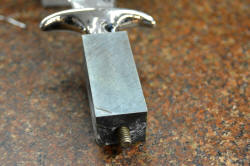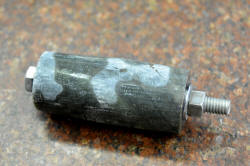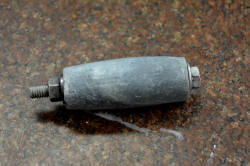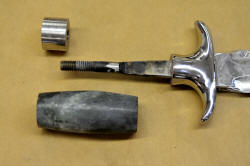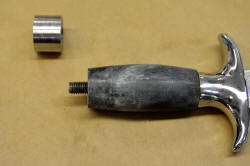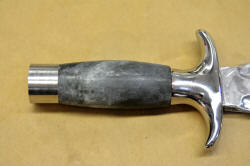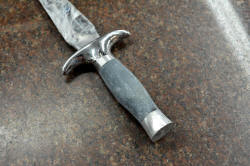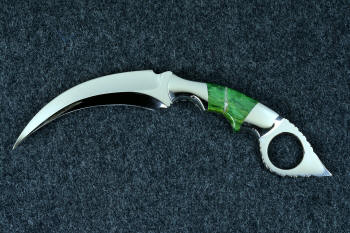Daqar
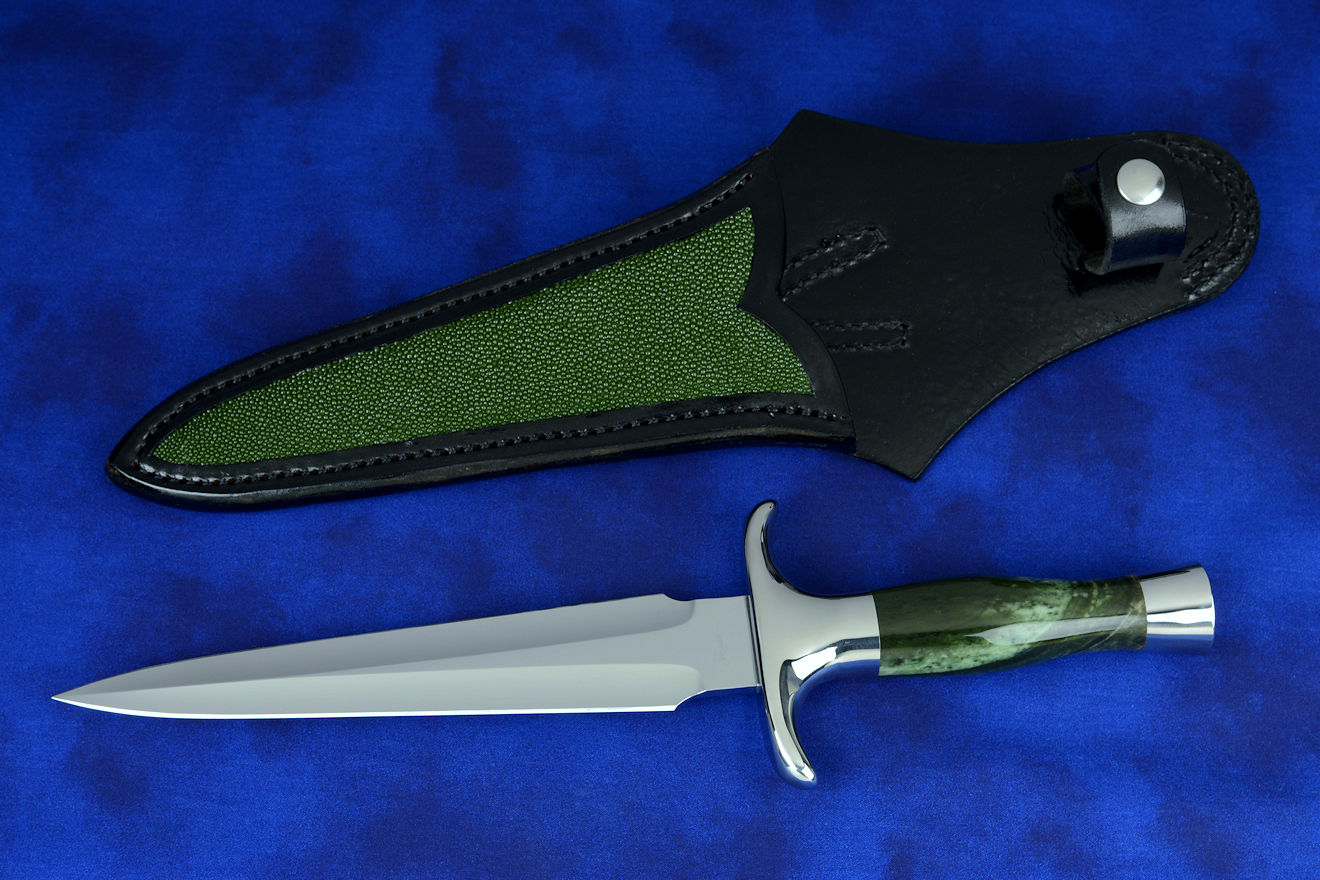
"Daqar" Fine Handmade Custom Dagger
- Size: Knife: Length overall: 13.25" (33.7 cm), Blade Length: 7.9" (20.0 cm), Thickness: 0.194" (4.9 mm)
- Weight: Knife: 1 lb. 4 oz. (567 grams), Sheath: 8.5 oz. (241 grams)
- Blade: CPM154CM High Molybdenum Powder Metal Technology Martensitic Stainless Steel, Cryogenically Treated, Hardened and Triple Tempered to Rockwell HRC60, Mirror Polished
- Fittings: 304 Austenitic Stainless Steel
- Handle: Nephrite Jade Gemstone (Wyoming)
- Sheath: Hand-carved Leather Shoulder inlaid with Green Rayskin
- The Inspiration: This is a very special custom
knife, made for a great client. He challenged me to offer my take,
my interpretation of what, in recent times, has been called a
commando knife. The origin of the word "commando" is Portuguese
and Latin. It's interesting to note that certain knives glean
contemporary interest, even though the actual designs may be
hundreds or even thousands of years old. The Fairbairn-Sykes
"Commando" knife is a recognizable form, brought to manufacture in
the 1940s as a weapon of the military and clandestine forces, not
only in Britain, but also in the United States. Millions of this
type of knife have been manufactured, so it's a popular style. The
actual form of the slender dagger originates in the bronze age, as
early as the Early Dynastic period (2900 B.C.). Daggers are very,
very old. Did you know that daggers were made 50,000 years ago in
the Stone Age, with
full, double-edged blades and solid handles? The F-S
(Fairbairn-Sykes) design was popular in its time, but has some
serious limitations. It's a small, thin, and weak knife, technically
a stiletto, but useful in its day. In this project, it's clear that
my client wished for an improvement of the form.
- Knife: The name of this knife is Daqar. Daqar
is the Greek-Hebrew word that means "to pierce through." Daqar
is used 11 times in the Bible; it's a very old word and appropriate
to the form. I wanted an incredibly clean, sleek, and smooth form,
focused on the elegance and function of the history of the dagger,
in the most advanced form, materials, and treatment.
- Blade: The steel for this project is
CPM154CM high alloy, hypereutectoid stainless tool steel. This is a powder metal technology tool steel, with
very high carbon, chromium, and molybdenum content. When
properly treated, this steel forms an extremely tough blade,
resistant to fracture, while being extremely wear resistant and
highly corrosion resistant. This is due to iron carbides,
chromium carbides, and molybdenum carbides that are formed and
improved when the steel is deeply cryogenically processed. I
heat treated this blade with an incredible and detailed process,
with quenching to -325°F and a 63 hour cryogenic soak for
full martensitic transformation and carbide development. With
triple tempering and deep cryogenic cycling between tempers, the
entire process to heat treat the steel took 15 steps and 95
hours. This sophisticated process is what is necessary to bring out the very best of
this steel's properties. These properties could not be superior
without an excellent geometry. I hollow ground the blade (unlike
the F-S knife which is a flat, diamond shape). This was done
with a 1.5" radius wheel so the edge would be extremely thin and
sharp while retaining the thick, strong, and supportive spine of the blade
The ricasso is thick and solid, supporting forces applied
through the
guard and handle. The blade is almost 8" long, with 7" of
razor-keen cutting edges. The geometry brings the blade to a
needle-like point, yet with great strength and toughness. I
mirror-polished the blade completely for the highest corrosion
resistance, durability, and beauty.
- Fittings: The original F-S commando knife
has a weak, small, and very thin piece of flat stock as the
guard, no doubt a cheap manufacturing decision rather than a
worthwhile device to protect the hand and apply pressure. In the
15th century, the Swiss started making guards that have quillons
that curve back
toward the hand in their daggers. This design guards the hand
and allows a curved, non-abrasive form to apply thrusting force, unlike
squared-off metal edges. This is also an improvement on the forward
quillon curves toward the blade that
are awkward and unaccommodating for the hand. The Daqar is designed this way,
fitted with large, long, full and protective quillons. The full guard and pommel
are made of zero-care, extremely
tough 304 austenitic high nickel, high chromium stainless steel.
I milled and sculpted the guard (see photos below) for a tight
fit on the blade tang, soldered and solid, while offering a
substantial smooth, clean, an effective protection for the hand
and device for applying force. The pommel is flared and threaded
to the tang with a large and deep mechanical design, has great balance and strength, and reinforces the
entire handle. Both the guard and the pommel are polished
throughout for the smoothest feel and the highest
corrosion-resistance and beauty.
- Handle: The handle of the F-S commando
knife is small, narrow, weak and thin, often made with coarse
knurling, or cast in ribbed brass or aluminum. They were always
extremely narrow and weak behind the guard. The Daqar
hidden tang handle had to be very tough and strong, the
strongest I could make it. In the photos below, you'll see a
welded tang of 304 stainless steel rod, in 3/8" (10 mm) diameter
thread. This is a large, heavy post, and it's solidly
welded to the tang, triple annealed for toughness at the welded
union. Only a few gemstones have the strength, toughness, and
durability to serve as a foundation material for a tactical
or combat knife, and this is one of them. I chose nephrite Jade
from Wyoming, an extremely tough and beautiful stone, for the handle.
Starting with a large jade boulder, I blocked out and selected with a
substantial core with the desired pattern and
orientation, and painstakingly drilled a tight, compact and
fitted hole completely through the stone. I bedded and fitted
the jade accurately to the guard and pommel. The fit is
flawless. I then ground and
finished the entire assembly in one piece for a uniform, rigid
and smooth feel. The jade is highly polished and will literally
outlast the rest of the entire knife! The shape of the handle is
inviting and ergonomic, with the swell of the stone resting in
the palm and the flare at the pommel retaining grip.
- Feel: There is nothing that feels as
solid, sleek, and dangerous as this knife. The balance is
perfect, right at the union of the gemstone and the guard, and
the full protection and complete form brings this knife to the
pinnacle of performance. This is not a delicate poking device;
this is a sizeable, strong, and rigid dagger.
- Sheath: One of the worst parts of the original
F-S commando knife was the "pancake-turner" style of thin, weak
leather sheath. Men would often have their own sheaths made for the
knives, as the originals were barely serviceable. For the Daqar, I
wanted a tough sheath, complimentary to the knife's design, use, and
style. Like the knife, I created a bold, clean, and uniform sheath
appropriate and tough, yet resilient and inviting. I made the sheath
in 10 oz. leather shoulder, hardened and sculpted, dyed black,
hand-carved and inlaid with large, full panels of green rayskin. The
ray is interlocking bone, the most durable natural skin available,
abrasion-resistant and tough. The design is clean and smooth, like
the knife, and even the belt loop is inlaid. The loop is double-row
stitched for strength, the entire sheath is tightly stitched with
polyester for strength, and the sheath is sealed with lacquer for
endurance and easy care. The retainer strap is a classic design,
with an all-stainless steel dot snap for zero-care.
- This is a beautiful, strong, and serious knife, made the very
best it can be with modern materials, design, and execution. I'll be
sad to see this one go, but my client will be very happy and I have
the photos below!
Thanks, P. K.!
Extraordinary take on the weapon. Perfect!
I see no reason the weapon can not be used for combat by a trained soldier.
--P.
Please click on thumbnail knife photos
